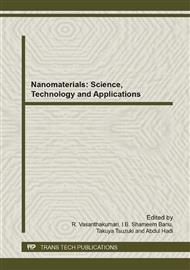[1]
Luiza de Castro Folgueras, Mirabel Cerqueira Rezende, Microwave Absorbing Nanocomposites Composed with and without Polyaniline by Use as Radar Absorbing Structure , Material Science Forum , 730 (2012 )920-924.
DOI: 10.4028/www.scientific.net/msf.730-732.920
Google Scholar
[2]
Jean-Baptiste Mathieu, Sylvain Martel, Magnetic Microparticle Steering within the Constraints of an MRI System: Proof of Concept of a Novel Targeting Approach, Biomed Microdevices, 9 (2007) 801-808.
DOI: 10.1007/s10544-007-9092-0
Google Scholar
[3]
Q. Xiao, X. Tan, L. Ji, J. Xue, Preparation and characterization of polyaniline/nano-Fe3O4 Composites via a novel Pickering emulsion route, Synthetic Metals, 157 (2007) 784-791.
DOI: 10.1016/j.synthmet.2007.08.010
Google Scholar
[4]
S. S. Umare, B. H. Shambharkar, R. S. Ningthoujam, Synthesis and characterization of polyaniline-Fe3O4 nanocomposite: Electrical conductivity, magnetic, electrochemical studies, Synthetic Metals, 160 (2010) 1815-1821.
DOI: 10.1016/j.synthmet.2010.06.015
Google Scholar
[5]
X. Lu, H. Mao, D. Chao, W. Zhang, Y. Wei, Ultrasonic synthesis of polyaniline nanotubes containing Fe3O4 nanoparticles, Journal of Solid State Chemistry, 179 (2006) 2609-2615.
DOI: 10.1016/j.jssc.2006.04.029
Google Scholar
[6]
Y. Yao, H. Jiang, J. Wu, D. Gu, L. Shen, Synthesis of Fe3O4 /Polyaniline Nanocomposite in Reversed Micelle Systems and its Performance Characteristics, Procedia Engineering, 27 (2012) 664-670.
DOI: 10.1016/j.proeng.2011.12.503
Google Scholar
[7]
H. -Y. Lee, S. -P. Rwei, L. Wang, P. -H. Chen, Preparation and characterization of core-shell polyaniline- polystyrene sulfonate@Fe3O4 nanoparticles, Materials Chemistry and Physics, 112 (2008) 805-809.
DOI: 10.1016/j.matchemphys.2008.06.050
Google Scholar
[8]
W. Shen, M. Shi, M. Wang, H. Chen, A simple synthesis of Fe3O4 nanoclusters and their electromagnetic nanocomposites with polyaniline, Materials Chemistry and Physics, 122 (2010) 588-594.
DOI: 10.1016/j.matchemphys.2010.03.051
Google Scholar
[9]
S.S. Umare, B.H. Shambharkar, R.S. Ningthoujam, Synthesis and characterization of polyaniline– Fe3O4 nanocomposite: Electrical conductivity, magnetic, electrochemical studies, Synthetic Metals, 160 (2010) 1815-1821.
DOI: 10.1016/j.synthmet.2010.06.015
Google Scholar
[10]
Y. Long, Z. Chen, J. L. Duvail, Z. Zhang, M. Wan, Electrical and magnetic properties of polyaniline/Fe3O4 nanostructures, Physica B: Condensed Matter, 370 (2005) 121-130.
DOI: 10.1016/j.physb.2005.09.009
Google Scholar
[11]
Jianguo Deng, Xiaobing Ding, Wenchuan Zhang, Yuxing Peng, Jianhua Wang, Xingping Long, Pei Li, Albert S. C Chan, Magnetic and conducting Fe3O4–cross-linked polyaniline nanoparticles with core–shell structure, Polymer, 43 (2002) 2179-2184.
DOI: 10.1016/s0032-3861(02)00046-0
Google Scholar
[12]
Wei Shen, Minmin Shi, Mang Wang, Hongzheng Chen, A simple synthesis of Fe3O4 nanoclusters and their electromagnetic nanocomposites with polyaniline, Materials Chemistry and Physics, 122 (2010) 588-594.
DOI: 10.1016/j.matchemphys.2010.03.051
Google Scholar
[13]
Jaroslav Stejskal, Irina Sapurina, Miroslava Trchová, Polyaniline nanostructures and the role of aniline oligomers in their formation, Progress in Polymer Science, 35 (2010) 1420-1481.
DOI: 10.1016/j.progpolymsci.2010.07.006
Google Scholar
[14]
Jyongsik Jang, Joonwon Bae, Kyungtae Lee, Synthesis and characterization of polyaniline nanorods as curing agent and nanofiller for epoxy matrix composite, Polymer, 46 (2005) 3677-3684.
DOI: 10.1016/j.polymer.2005.03.030
Google Scholar
[15]
M. Racuciu, D.E. Creang¸ and A. Airinei, Citric-acid coated magnetite nanoparticles for biological applications, European Physics Journal E, 21(2006) 117-121.
DOI: 10.1140/epje/i2006-10051-y
Google Scholar
[16]
S. Laurent, D. Forge, M. Port, A. Roch, C. Robic, L. Vander Elst, R. N. Muller, Magnetic Iron Oxide Nanoparticles: Synthesis, Stabilization, Vectorization, Physicochemical Characterizations, and Biological Applications, Chemical Reviews, 108 (2008).
DOI: 10.1021/cr068445e
Google Scholar


